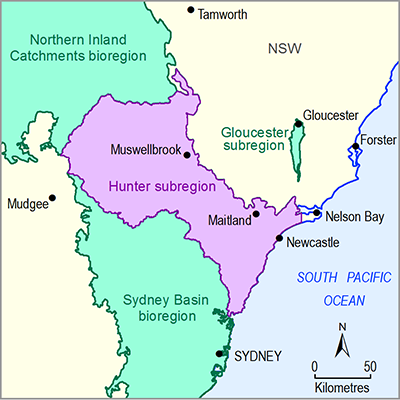- Home
- Assessments
- Bioregional Assessment Program
- Hunter subregion
- 1.5 Current water accounts and water quality for the Hunter subregion
Executive summary

This product contains information on surface water and groundwater quantity and quality for the Hunter subregion. The information was captured through to June 2016 and used in the evaluation of the potential impact of coal seam gas and coal mining development on water and water-dependent assets.
The Hunter subregion has two main river basins: the Hunter river basin and the Macquarie-Tuggerah Lakes basin.
Water accounts
Hunter river basin
The Hunter river basin includes regulated and unregulated sections. Unregulated sections include tributaries upstream of Lake Glenbawn, the Goulburn River and its tributaries in the west and smaller tributaries along the regulated sections; the regulated section is mainly regulated by releases from Glenbawn Dam and Glennies Creek Dam.
There are five major water storages supplying the Hunter subregion. They have a combined storage capacity of 1254 gigalitres. Since 1991 they have been about 70 to 75% full at the end of the water year (30 June). The three main groundwater aquifers in the Hunter subregion can be classified into alluvial, coastal sands and fractured rock aquifers. The volume of water stored in the aquifers is not known.
Gauging stations are located along the river downstream of the major dams and on major tributaries. Between 2004–05 and 2011–12, water flow in to the Hunter River from gauged tributaries was 1135 gigalitres per year.
Water use is managed through a system of water entitlements and water rights. Total surface water entitlements in the Hunter river basin are approximately 767 gigalitres per year. Across all water sources, major water utilities hold most of the entitlements—about 380 gigalitres per year (50%). General security and unregulated river licences account for another 34% of the entitlement volume—about 260 gigalitres per year—with supplementary permits, high security licences, local water utilities and stock and domestic accounting for the remaining licences. Coal mines hold about 47 gigalitres of general, high and supplementary water licences, including 55% of high security licences.
Water use data are not available for a large part of the subregion, except the Hunter Regulated River water source. Between 2010–11 and 2013–14, the average annual water extraction of 117 gigalitres was 54% of the long-term average annual extraction limit (LTAAEL) of 217 gigalitres per year.
Macquarie-Tuggerah Lakes basin
The Macquarie-Tuggerah Lakes basin includes three major rivers: Dora Creek, Wyong River and Ourimbah Creek. In the Macquarie-Tuggerah Lakes basin, mean annual inflow for 2004–05 to 2011–12 was 89 gigalitres per year. There was not enough annual mean recharge data for groundwater aquifers to provide a meaningful total.
Water quality
Hunter river basin
Water quality has been poor due to high salt concentrations in parts of the Hunter river basin. This is largely due to the geology of the area, but may have been exacerbated in the Hunter River by discharges of saline groundwater from mining operations and rising groundwater levels from past land clearing.
The Hunter River Salinity Trading Scheme (HRSTS) was introduced in 1995 to minimise the impact of saline water discharges from industry. There are three key salinity monitoring stations located on the Hunter Regulated River—Denman, Glennies Creek and Singleton.
Salinity levels are typically low in the north-east of the river basin, which has important water supply catchments. In the Wybong and Goulburn rivers and around Lake Liddell the salinity levels are higher. Along the Hunter Regulated River the mean electrical conductivities between the years 1995 and 2013 varied from around 600 microsiemens per centimetre at Denman to 750 microsiemens per centimetre at Glennies Creek to 640 microsiemens per centimetre at Singleton. All sites exhibit high variability, particularly at low flows when baseflow discharges dominate the streamflow response.
The groundwater quality data available for the Hunter subregion were generally poor and difficult to draw firm conclusions from. Analysis of the available salinity data indicated that salinity in the coastal sands aquifer was on average lower than in alluvial and fractured rock aquifers—although the results are not statistically significant as they are based on five samples only.
There are large ranges in salinity in the alluvial (21 to 14,500 microsiemens per centimetre) and fractured rock aquifers (29 to 48,600 microsiemens per centimetre) but major errors were found in the dataset that undermine confidence in these ranges. For most samples, the hydrostratigraphic unit from which they were obtained was not known. Possibilities for beneficial use of water are provided based on median electrical conductivity values. Some trace element data are presented for groundwater, but it is difficult to provide meaningful interpretation given the limited number of samples for some elements and lack of information about the water sources sampled and origins of the trace elements.
Macquarie-Tuggerah Lakes basin
No surface water quality information was available for the Macquarie-Tuggerah Lakes basin.

- 1.5.1 Current water accounts
- 1.5.1.1 Surface water
- 1.5.1.1.1 Water storage in the Hunter river basin
- 1.5.1.1.2 Water storage in the Macquarie-Tuggerah lakes basin
- 1.5.1.1.3 Gauged inflows and outflows in the Hunter river basin
- 1.5.1.1.4 Gauged inflows in the Macquarie-Tuggerah lakes basin
- 1.5.1.1.5 Surface water entitlements and allocations
- 1.5.1.1.6 Water use in the Hunter Regulated River water source
- 1.5.1.1.7 Gaps
- References
- Datasets
- 1.5.1.2 Groundwater
- 1.5.1.1 Surface water
- 1.5.2 Water quality
- Citation
- Acknowledgements
- Contributors to the Technical Programme
- About this technical product
